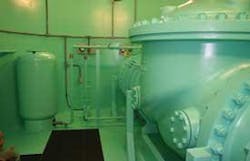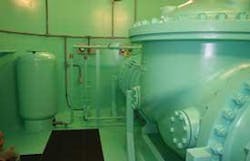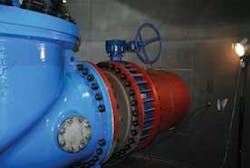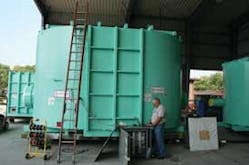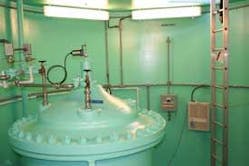The Michigan city of Warren is supplied by Detroit DWSD. Improvements to the existing 42” transmission main resulted in higher pressures for Warren. Line pressure is expected to vary from 50 to 100 psig. To reduce the high pressure, Warren is installing four new factory-built pressure reducing stations. One of these connections, at Groesbeck Highway, is a 36" connection using a true 36" diaphragm control valve. This station is the largest factory-built control valve station ever manufactured using a single control valve.
The project Consulting Engineer is Anderson, Eckstein, and Westrick, Shelby, MI. The Project Engineer is Lyle E. Winn, P.E. ([email protected]). With the decision to use factory-built pressure reducing stations, the engineer and the city solicited design proposals and interviewed station and control valve manufacturers. Engineered Fluid Inc. (EFI), Centralia, IL, was chosen as the designer, controls integrator and manufacturer of the pressure reducing stations. Cla-Val of Huntington Beach, CA, was selected as the control valve manufacturer. Installation of the stations was competitively bid. The EFI Rep for this project is Kerr Pump & Supply, Oak Park, MI.
EFI is responsible for fully integrating the mechanical aspects of the pressure reducing stations with the control requirements for single system responsibility.
The project design requirement is to maintain discharge pressure within ± 1 PSIG of the outlet pressure set point. EFI accomplished this level of control with a dual solenoid, electrically operated pilot system. Outlet pressure and inlet back pressure sustaining control is provided. Set-point control is accomplished through use of a Programmable Logic Controller (PLC) based control and telemetry system, designed and manufactured by EFI.
The PLC receives analog signals from inlet and outlet pressure transducers, and a valve position indicator. The analog signals are processed by the PLC algorithms and compared to the set-points and control valve position. Based on the deviation of actual pressures from the set-points, the PLC sends signals to the respective solenoid points. The solenoid valves let water into the valve dome for closing action or let water off the dome to open the valve. The solenoid valve actions maintain the inlet back pressure sustaining and outlet pressure set-points.
The inlet back pressure sustaining and outlet pressure set points are changed locally at the stations or remotely by telemetry link to the Warren DPW for varying system requirements. Warren can override the automatic controls to manually open or close the valves locally or remotely. Station status, inlet and outlet pressure, valve position, and alarms are transmitted by the telemetry control system to the Warren DPW offices.
At times, the pressure differential available to power the control valve is insufficient to operate the valve. To ensure sufficient hydraulic pressure to control the 36” valve, a pilot control water system was designed into the station. This control water system includes a pump, bladder tank, and controls for pump start/stop based upon pressure.
The control and isolation valves and the valve control system are constructed into a water-tight steel capsule. The construction of the steel capsule is designed to resist corrosion and provide a long service life. All manufacturing steps are performed under a Total Quality Management program.
Particular attention for the capsule construction is given to material selections, surface preparation, welding, and coatings for long term corrosion resistance. The transmission piping is 3/8” wall steel pipe. The welding is Metal Inert Gas (MIG) performed on automatic equipment for welding precise weld heat settings, weld wire feed rates, and weld lay down rates.
Prior to and after welding all inside and outside pipe surfaces, they are blasted to near white SSPC-10. Following welding of the pipe sections, all the piping is internally coated with fusion bonded epoxy performed according to AWWA-C-213. The exterior pipe surfaces and the capsule shell surfaces, inside and outside, are coated with two coats of a two-part epoxy coating followed by Holiday testing.
The control valve by Cla-Val has an international flavor; it was cast in Bosnia, machined and fitted in Switzerland and shipped to the U.S. through Canada. The shipping weight of the valve was 19,000 pounds. The valve has stainless steel internal parts, a cast iron body and is fusion bonded epoxy coated. EFI manufactured the valve pilot control system at its Centralia facility.
